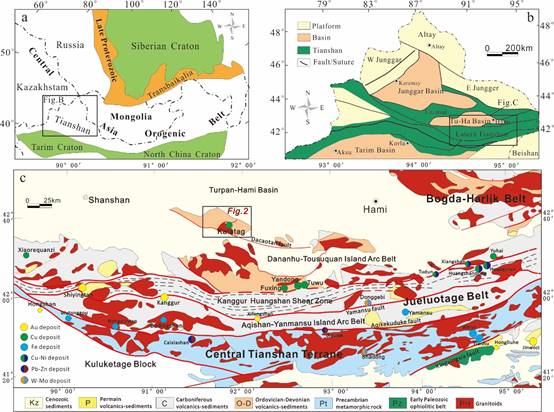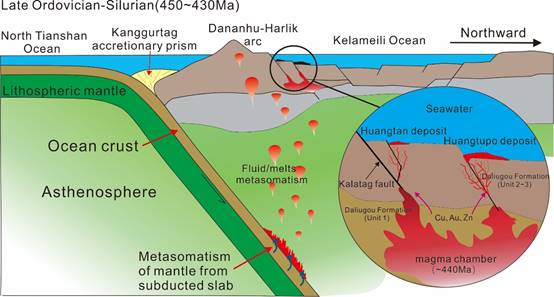

The Huangtan Au-Cu deposit is was recently discovered in the Kalatag district, Xinjiang, NW China. It is one of the few Early Paleozoic volcanic massive sulfide (VMS) deposits in the East Tianshan. The deposit is predominantly hosted by Early Paleozoic volcanic rocks and quartz diorite pluton. The dacitic tuff and quartz diorite have zircon ages of 438 ± 5 Ma and 439.2 ± 1.4 Ma, respectively, determined by LA-ICP-MS U-Pb dating. Re-Os dating of pyrite from the vein ore yielded a weighted average age of 437.9 ± 6.6 Ma, which is classified as Early Silurian. These ages and geological observations demonstrate that Cu-Au mineralization is temporally and spatially related to the quartz diorite and volcanic rocks.
The volcanic rocks, including basalt, andesite, and dacitic tuff, are calc-alkaline with low Mg# values (22.6–45.1), enriched in light rare earth elements (LREE) and depleted in high-field-strength elements (HFSE) (e.g., Nb, Ta, and Ti) and are characterized by high εNd(t) (+5.3–+7.2), low (87Sr/86Sr)i (0.70367–0.70474) and high εHf(t) (+6.94 – +12.76). They are considered to be originated from mantle-derived mafic magmas that mixed with partial melting of a juvenile basaltic lower crust and underwent a high degree of fractional crystallization during emplacement. The quartz diorite is classified as metaluminous-to-peraluminous, calc-alkaline to high-K calc-alkaline. It is enriched in large ion lithophile elements (LILE) (e.g., K, Ba, Rb, and Sr), and depleted in HFSEs (e.g., Nb, Ta, and Ti) with lower Sr/Y ratios, indicating a subduction-related origin. It displays low (87Sr/86Sr)i (0.70381–0.70469), high εNd(t) (+6.2 - +7.1) and zircon εHf(t) (+8.82 - +14.90). The quartz diorite has a similar magma source with volcanic rocks and was likely derived from depleted mantle metasomatized by subduction-related fluids.
A tectonic model is consequently proposed to explain the Early Paleozoic magmatism and VMS mineralization in the Kalatag area. Huangtan igneous rocks were generated by the northward subduction of the North Tianshan oceanic plate beneath the Dananhu-Harlik island arc during Early Paleozoic. The Huangtan Au-Cu deposit may be an important branch of the adjacent Huangtupo VMS deposit, providing a model for the exploration of Early Paleozoic VMS Cu-metallogenic systems in the Eastern Tianshan region, NW China.
Please cite:Sun B, Ruan B*, Lv X, Tuohan B, Ratchford M E. Geochronology and geochemistry of the igneous rocks and ore-forming age in the Huangtan AuCu deposit in the Kalatag district, Eastern Tianshan, NW China: Implications for petrogenesis, geodynamic setting, and mineralization[J]. Lithos. 2020, 368-369: 105594.
url:https://authors.elsevier.com/a/1bBgi5aRZVtBc

Fig. 1. (a) Location of the study area in the Central Asia Orogenic Belt (modified from Huang et al., 2013). (b) Sketch map showing the geological units of the Tianshan Belt (modified from Chen et al., 2012). (c) Simplified geological map of the Eastern Tianshan Belt (modified from Wang et al., 2006)

Fig. 2. Schematic diagram showing a north dipping subduction of North Tianshan Oceanic plate during Late Ordovician-Silurian and the tectonic model for the Kalatag district.